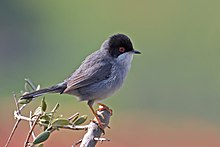| Dartford Warbler |
|---|
 |
| Female in Spain |
| Conservation status |
|---|

Near Threatened (IUCN 3.1)
|
| Scientific classification |
|---|
| Kingdom: | Animalia |
| Phylum: | Chordata |
| Class: | Aves |
| Subclass: | Neornithes |
| Infraclass: | Neognathae |
| Superorder: | Neoaves |
| Order: | Passeriformes |
| Suborder: | Passeri |
| Infraorder: | Passerida |
| Superfamily: | Sylvioidea |
| Family: | Sylviidae |
| Genus: | Sylvia |
| Species: | S. undata |
| Binomial name |
|---|
Sylvia undata
(Boddaert, 1783) |
The Dartford Warbler, Sylvia undata, is a typical warbler from the warmer parts of western Europe and northwestern Africa. Its breeding range lies west of a line from southern England to the heel of Italy (southern Apulia). The Dartford Warbler is usually resident all year in its breeding range, but there is some limited migration.
Description and systematics
The Dartford Warbler is a small (13 cm) passerine bird, distinguished by its long tail compared with that of other warblers. Its plumage comprises unobtrusive and muted tones, which blend in with the dry dead plants, old wood or sunny greyish wood found in its preferred habitats.
Like many typical warblers, the Dartford Warbler has distinct male and female plumages. The male has a grey back and head, reddish underparts, and a red eye. The reddish throat is spotted with white. The sides are a dull greyish tone, being more clear about the abdomen. In some populations males have bluish-grey or brownish-grey backs and heads. The female is paler below, especially on the throat, and a browner grey above. The female's throat also has white spots, although they are smaller and less marked than in the male. Juvenile birds are similar to females.
The song of the Dartford Warbler is a distinctive rattling warble.
The type locality of the Dartford Warbler is Provence in France. This species probably forms a superspecies with Tristram's Warbler and this in turn seems close to Marmora's Warbler and the Balearic Warbler. Altogether, this group of typical warblers bears a resemblance to the Wrentit, the only species of Sylviidae from the Americas. However the Wrentit is less closely related to the genus Sylvia than to the parrotbills. Its visual similarity to the Dartford Warbler group is an example of convergent evolution.
Ecology and status
This small "warbler" species breeds in heathlands, sometimes near coasts, with gorse bushes for nesting. Like its relatives, the Dartford Warbler is insectivorous, but will also take berries. The nest is built in low shrub, and 3-6 eggs are laid. It inhabits open fields with Jara and degraded scrub brush. Common in heather. In winter may be coming to urban solitary areas, but always it find shrubs in these areas. This shy warblers avoiding to the people. Nests in bushes with thorns and near the ground.
The species is naturally rare. The largest European populations of Sylvia undata focus on Iberian peninsula, and less in large part of France in Italy and southern England. In Africa can be found only in small areas in the north, being present as wintering in northern Morocco and northern Algeria. These warblers are mostly insectivore, feeding caterpillars, butterflys,beetles,
Spiders and larvas, etc.
Dartford Warblers are named for Dartford Heath in north west Kent, where the population became extinct in the early 20th century. They almost died out in the United Kingdom in the severe winter of 1962/1963 when the national population dropped to just 10 pairs. However, this species can recover well in good quality habitat, thanks to repeated nesting and a high survival rate for the young. Indeed they recovered in some areas of the UK, but numbers are once again on the decline in other regions of that country, as well as elsewhere.
Formerly classified as a 'Species of Least Concern' by the IUCN,it was suspected to be rarer than generally assumed. Following the investigation of the apparent decline this was confirmed, and the Dartford Warbler was consequently uplisted to Near Threatened status in 2008.
Sub-species
- Sylvia undata dartfordiensis (south England and north-west France)
- Sylvia undata toni (north-west Africa)
- Sylvia undata undata (Iberian Peninsula and south France)
- Sylvia undata aremorica
- Sylvia undata naevalbens


















